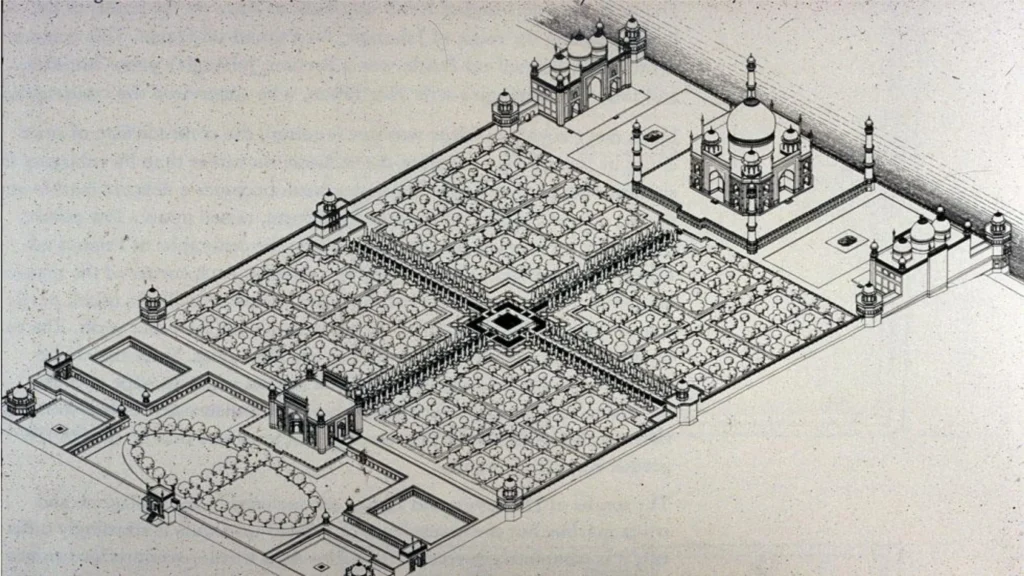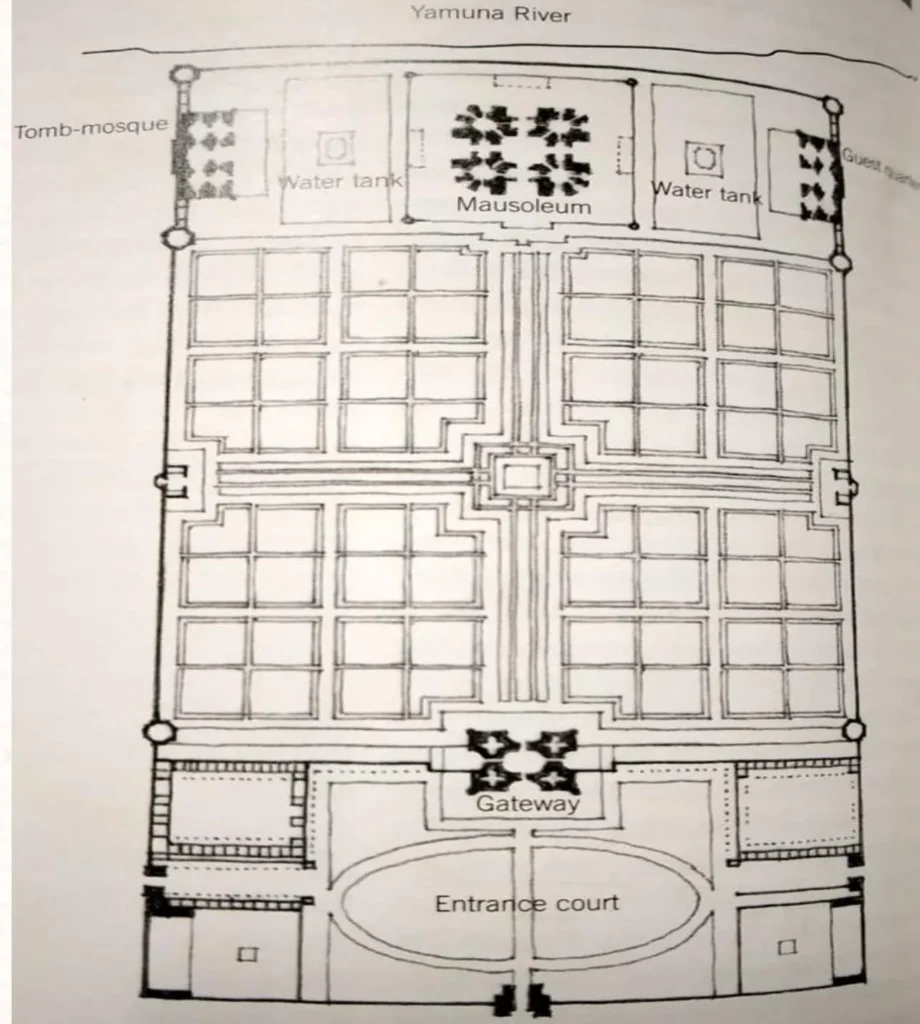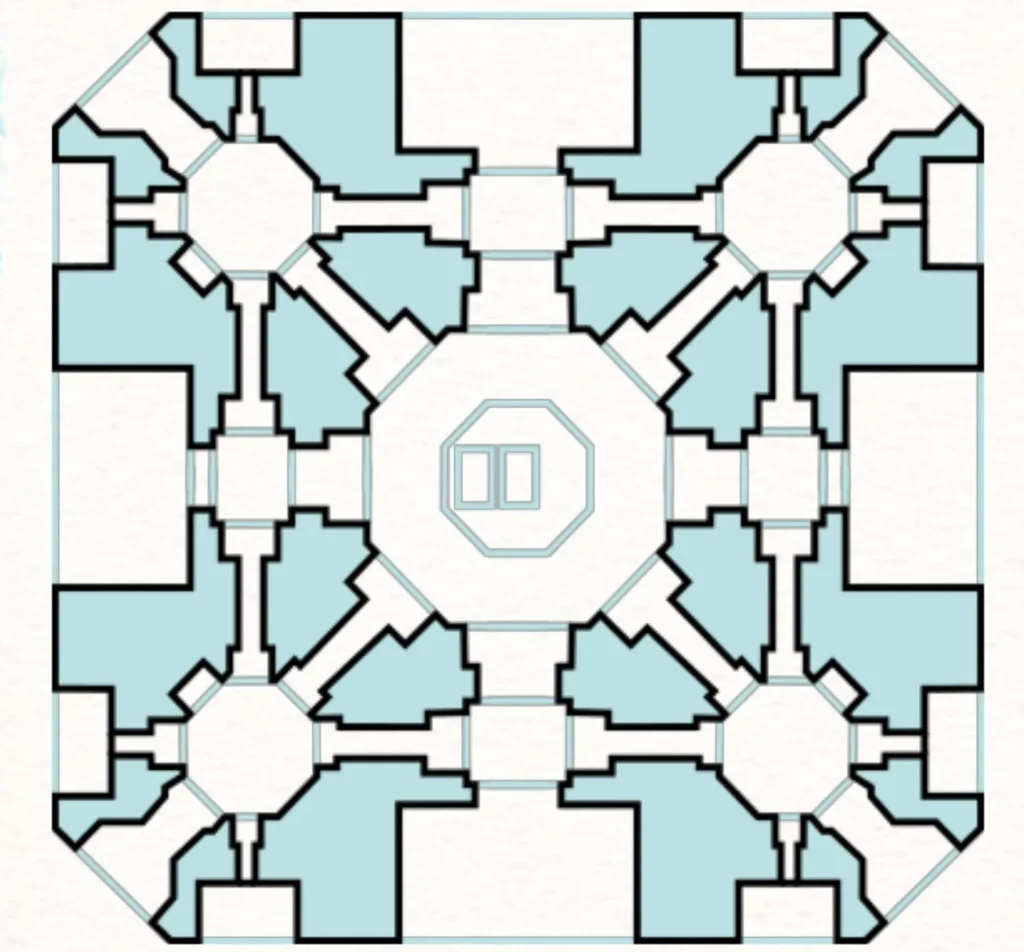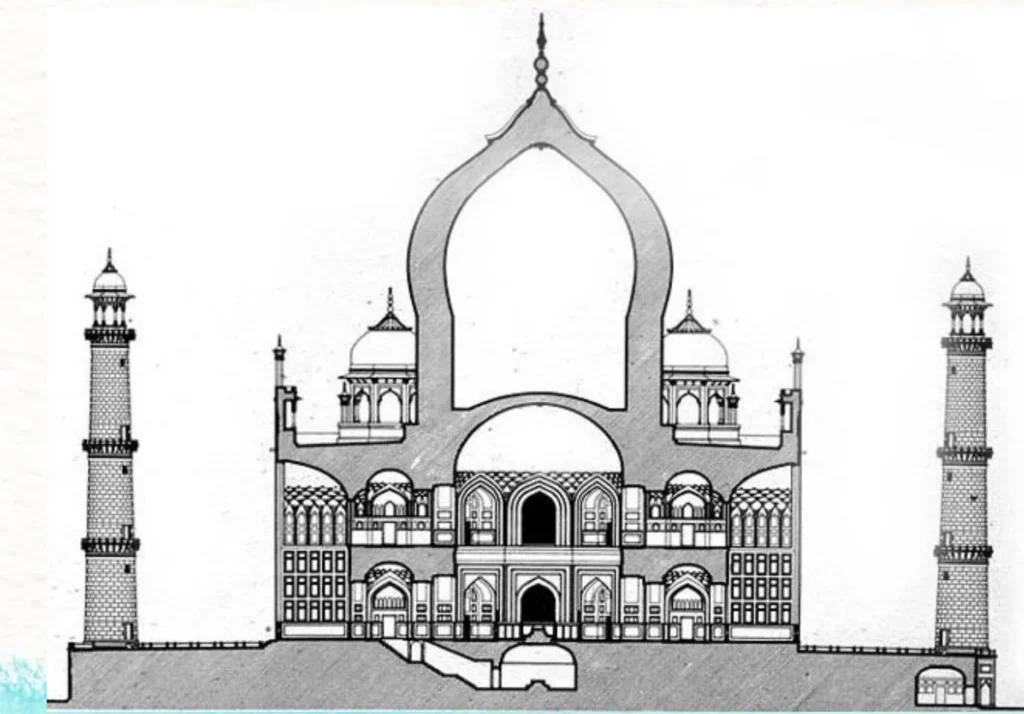If you want to know about egyptian architecture or form in architecture or general building requirements, please click the link.
Taj Mahal is considered one of the greatest examples of Mughal architecture, a blend of Indian, Persian, and Islamic styles. Built in Agra, India, it was commissioned by Mughal Emperor Shah Jahan in memory of his beloved wife Mumtaz Mahal and took 22 years to complete.
- Taj Mahal is a beautiful monument built on the bank of Yamuna River in Agra. It is made up of white ivory marble. It was built as a tomb for Mumtaz Mahal, the beloved wife of Mughal Emperor Shah Jahan. The monument includes a mosque and a guest house along with a garden which surrounds the monument from three sides.
- Taj Mahal means “Crown Palace” and is in fact the most well preserved and architecturally beautiful tomb in the world. The English poet, Sir Edwin Arnold has described The Taj as “Not a piece of architecture, as other buildings are, but the proud passions of an emperor’s love wrought in living stones.”
- It was built by the fifth Mughal emperor, Shah Jahan in 1631 in memory of his third but the most favourite wife, in fact a soul-mate Mumtaz Mahal, a Muslim Persian princess.
1) Area Map of Agra
Agra is a city located in the northern Indian state of Uttar Pradesh. It is known for being home to the Taj Mahal, one of the Seven Wonders of the World and a UNESCO World Heritage site.

2) Taj Mahal (Rauza – I- Munavvara)
The tomb in the Taj Mahal complex was known as Rauza-I-Munavvara to the Mughals. “Rauza” means tomb or shrine, and “Munavvara” is a Persian word meaning “illumined.” So, the name Rauza-I-Munavvara can be translated as “The Illumined Tomb.”
The name reflects the purpose of the building, which was intended as a final resting place for the Mughal empress Mumtaz Mahal, and as a symbol of love and devotion by her husband, Emperor Shah Jahan. The intricate decoration and use of precious stones in the design are meant to create an atmosphere of radiance and reverence, fitting for a mausoleum of such beauty and significance.
- The tomb was known to the Mughals as Rauza – I- Munavvara (the “Illumined Tomb”) because of the luster and transparency of its marble. Later it was also referred to as Rauza- I- Mumtaz Mahal, which the English contracted to Taj Mahal in the 19th century.
- Mumtaz Mahal died unexpectedly in 1631 while giving birth to her fourteenth child.
- 20,000 workmen labored for 15 yrs. for her tomb. Shah Jahan was also buried on Mumtaz’s right, feet facing south, and closer to the Kaaba, as required by the Islam.
3) Taj Mahal’s Architect ???

- Historical records list says that several people are responsible for the tomb or parts of it.
- Ismail Khan from Turkey may have designed the dome.
- Qazim Khan from Lahore cast its gold finial.
- Chiranjilal, a local from Delhi was the chief sculptor and mosaicist.
- Amanat Khan from Shiraz was the chief calligrapher.
- Other specialists included sculptors from Bukhara, calligraphers from Syria and Persia, inlayers from South India, & stonecutters from Baluchistan.
- 37 men can be counted in its creative nucleus.
- In this sense, Taj Mahal was a global project.
- Yet given that Shah Jahan personally supervised the design & approved every aspect of project, he must be recognized as the chief architect of the Taj Mahal.
4) Site Plan of Taj Mahal

- The main tomb is on the southern bank of the Yamuna River on a vast platform 103 meters square & 7m. High, erected on arches.
- To its west, stands a mosque, made of sandstone, with 3 modest marble domes.
- To its east is an identical structure, placed there to provide symmetry.
- Reflected in the wide waters of the Yamuna, which slowly flows in Agra, the Taj Mahal seems to be an apparition of domes & minarets rising above the plain.
- The side usually depicted today is actually the building’s rear; the Mughal emperors accessed it from the water, arriving by means of a special barge that docked at northeastern edge of the platform, from which a stair leads up to the tomb.
- Land based access to the taj is from its southern garden.
5) Mughal Gardens

- With an area of 6.9 hectares, was projected as representing the earthly paradise, in the style of Persian gardens introduced in India by Babur, the first Mogul emperor.
- Originally contained a multitude of exotic flowers and trees, everything in them available geometric and perfectly symmetrical: gardeners worked with the conscious effort to translate to heavenly perfection earthly terms, following a series of formulas well known. Thus, the four, number sacred in Islam and was the basis of the entire design.
- The channels, the symbol of the four rivers of paradise (of which, according to tradition, manaba water, milk, wine and honey), with fountains and flanked by cypress trees (which, in addition to providing shade, accentuating the lines of perspective), Cross in the center forming a pond of water lilies in white marble, slightly elevated above the ground, a symbol of AL Kawthar, the celestial pond in the abundance mentioned in the Koran, was designed so that the mausoleum be reflected in its waters.
- Each of the four parties that surround channels are divided by shrubbery in sixteen stone paths.
- In the Mughal architecture, water is used both for ritual ablution to cool and humidify the environment, a wise combination of religious significance to the practical need. Was extracted from the river and canals will be introduced in some underground stems from which to fill the ponds and water gardens you.
6) Plan of Taj Mahal (Nine-Fold Plan)

The Taj Mahal complex is designed according to a nine-fold plan, which is a traditional Indian architectural concept. This concept involves dividing a building or site into nine equal parts, creating a harmonious and balanced composition.
In the case of the Taj Mahal, the nine-fold plan is used to create symmetry and balance in the overall design of the complex. The central tomb is surrounded by four minarets at the corners, creating a clear axis along the north-south and east-west directions. The mosque and guest house are located on either side of the tomb, forming a balanced composition with the main structure.
The main tomb is a perfect cube, with a height equal to its width and length. This creates a sense of balance and stability in the central structure. The minarets are slightly tapered and are positioned at an angle, so that if one were to fall, it would fall away from the tomb.
The large central dome of the tomb is surrounded by smaller domes and arches, which add depth and dimension to the design. The intricate carvings, inlaid precious stones, and calligraphy that adorn the surface of the building further enhance the beauty and balance of the design.
The nine-fold plan concept is a key element of the design of the Taj Mahal and contributes to its reputation as a masterpiece of architecture. The use of symmetry, balance, and traditional Indian design elements creates a harmonious composition that has captivated visitors for centuries.

In architecture Hasht-Bihisht (Persian: تشهب تشه lit. ‘Eight Paradises’) refers to a Specific type of floorplan common in Persian architecture and Mughal architecture whereby the plan is divided into 8 chambers surrounding a central room. The eight divisions and frequent octagonal forms of such structures represent the eight levels of paradise for Muslims.

The hasht-bihisht design concept is a common feature in Persian and Mughal architecture, and is meant to symbolize the eight levels of paradise in Islam. The central room is considered the ninth paradise, and represents the ultimate reward for believers in the faith.
The eight surrounding chambers can be used for various purposes, such as living quarters, storage, or private meditation. The chambers are often arranged around a central courtyard, creating a harmonious and balanced composition. The octagonal shape of the building and its central room further emphasize the symmetry and balance of the design.
The hasht-bihisht design concept was widely used in the construction of palaces, tombs, and other buildings in the Persian and Mughal empires. It was seen as a way to create a building that reflected the ideals of the Islamic faith and symbolized the paradise that awaited the faithful in the afterlife.
Today, the hasht-bihisht design concept remains a popular element in Islamic architecture and is used in the construction of buildings around the world. Its enduring popularity is a testament to the beauty and symbolism of the design concept, and its importance in the architectural heritage of the Islamic world.
7) Cenotaph Area
The Taj Mahal complex consists of several structures, including two main tombs, a mosque, a guest house, and a large garden. The central feature of the complex is the main tomb, which houses the remains of Mumtaz Mahal and Emperor Shah Jahan.

Within the main tomb, there are two cenotaphs, or empty tombs, which are the focus of the interior. The cenotaphs are located in a large central chamber, with smaller chambers on either side. The cenotaph of Mumtaz Mahal is located in the center of the chamber, and the cenotaph of Emperor Shah Jahan is located to the right.
The cenotaphs are made of white marble and are intricately carved and decorated with precious stones and calligraphy. They are surrounded by a railing, with a false tomb below and a false sarcophagus above. The real tombs of the couple are located in a lower chamber, which is not accessible to the public.
The cenotaph area of the Taj Mahal is considered one of the highlights of the complex, and is famous for its beauty and intricate decoration. Visitors to the Taj Mahal often spend time admiring the cenotaphs and the surrounding architecture, taking in the beauty and grandeur of the mausoleum.
8) Mass and Space rendered as figures
In architecture, mass and space are important elements that contribute to the overall design of a building. Mass refers to the physical material that makes up the structure of a building, such as the walls, floors, and roof. Space refers to the area within and around the building that is occupied by air, light, and other elements.

In the case of the Taj Mahal, the interplay between mass and space is an important part of the overall design. The mass of the building, with its large domes, arches, and walls, creates a sense of stability and solidity. The spacious interior and large open courtyards create a sense of lightness and openness, and allow for an abundance of natural light to enter the building.
The use of mass and space in the Taj Mahal creates a harmonious and balanced composition, and contributes to its reputation as a masterpiece of architecture. The interplay between these two elements allows the building to embody both strength and beauty, making it a timeless work of art.
9) Section of Taj Mahal
A section of a building is a vertical cross-section that shows the internal structure and layout of a building. In the case of the Taj Mahal, a section would reveal the various levels and spaces within the building, including the basement, ground floor, first floor, and central dome.

In a section of the Taj Mahal, one would see the central tomb with its cubic shape and large central dome. The interior of the tomb is divided into several levels, with a lower level for the crypts and an upper level for the main chamber. The central dome is surrounded by smaller domes and arches, which help to distribute the weight of the dome and create a sense of height and grandeur.
In the basement of the Taj Mahal, one would see the rooms used for storage and other functional purposes. The ground floor is composed of the main entrance, a mosque, and a guest house. The first floor contains a spacious main chamber that is surrounded by smaller rooms and balconies.

Overall, a section of the Taj Mahal would reveal the intricate design and construction of the building, and demonstrate how the interplay of mass and space creates a harmonious and balanced composition. The use of symmetry, balance, and traditional Indian design elements is evident in the section, and contributes to the building’s reputation as a masterpiece of architecture.
10) Building Materials
The Taj Mahal was built using a variety of building materials, including marble, sandstone, jasper, jade, turquoise, and precious stones.
The main material used in the construction of the Taj Mahal is white marble, which was sourced from the town of Makrana in Rajasthan. The marble was transported over a distance of more than 800 kilometers to Agra, where it was used to create the intricate carvings, inlaid designs, and smooth surfaces that are characteristic of the building.
In addition to marble, the Taj Mahal also features intricate inlaid designs made from a variety of semi-precious stones, including jasper, jade, turquoise, and others. These designs are set into the marble surfaces and add a beautiful and colorful detail to the building.
Sandstone was used for the foundation and lower parts of the building, and for the surrounding walls and gatehouses. The sandstone provides a contrast to the white marble of the main building, and gives the Taj Mahal a sense of grounding and stability.
- Although the bulk of the building material is from South Asia, the Taj Mahal’s ornamental materials came from all round Eurasia.
- Its marble and red sandstone came from the hills of Makrana, near Jaipur, Rajasthan.
- From central Asia came nephrite jade and crystal; from Tibet turquoise; from upper Burma yellow amber; from Badakhshan in northeastern Afghanistan, lapis lazuli; from Egypt, chrysolite; and from the Indian Ocean, rare shells, coral & mother of pearl.
- Topazes, onyxes, garnets, sapphires, and bloodstones were among the 43 types of precious & semi- precious stones from all around India that were used.
- A distinguishing characteristic of the Taj Mahal’s massing is that in elevation, all the elements are clustered & hierarchically arranged to ensure that they do not compete with each other & instead build up the centrality of the main dome.
Overall, the use of high-quality building materials and the intricate details of the construction contribute to the beauty and durability of the Taj Mahal, and make it one of the most magnificent structures in the world.